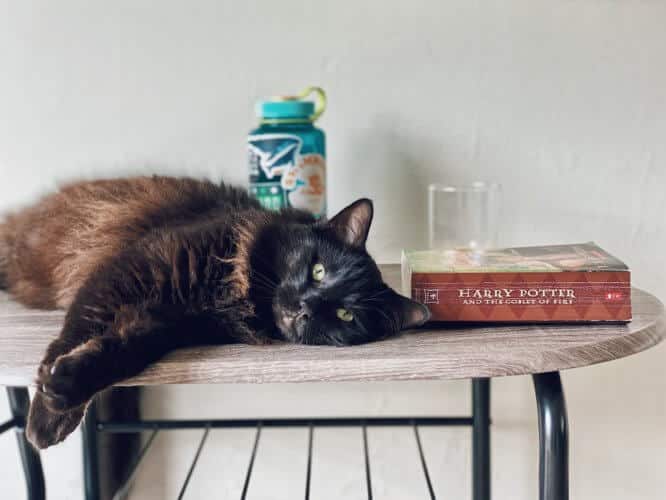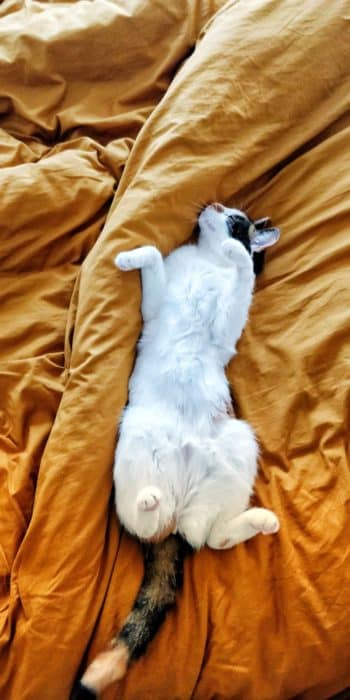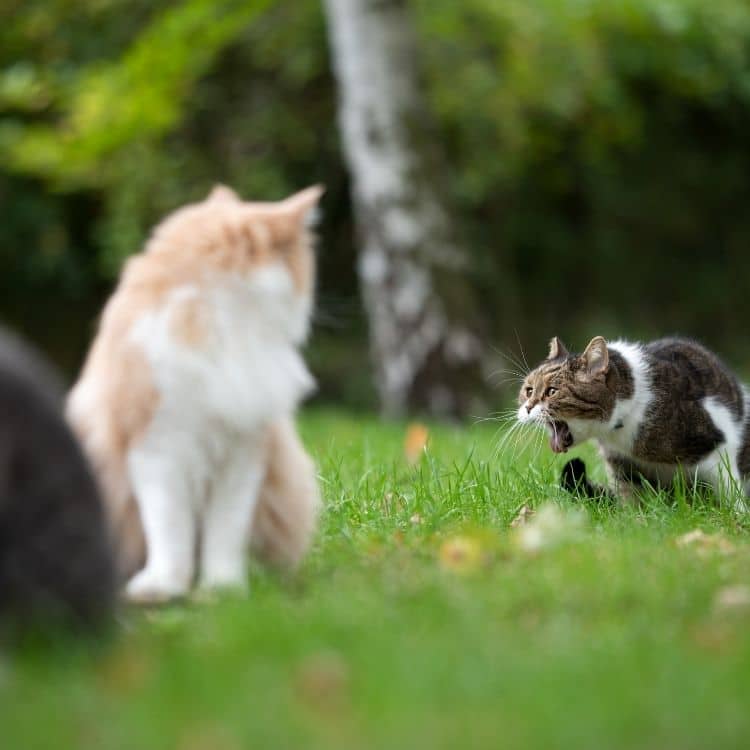You let your cat play with the plastic wrapper, and before you know it, your cat chews some of it. The next thing you’re asking is – what can I do if my cat ate plastic wrapper?
Cats are naturally curious – they seem to always find something interesting to play with or snack on. It’s not so uncommon for cats to chew or eat things that they shouldn’t. Before you start worrying about the consequences, let’s dive deeper into this topic.
In this article, we discuss what you should do in this situation and the possible consequences of it.
My Cat Ate Plastic Wrapper – What Should I Do?

There are plenty of reasons as to why your cat likes eating plastic.
Plastic objects such as plastic bags, wrappers, cups, straws, or similar – are often used to hold food or drinks. Your cat may be attracted to this plastic because it senses the scent of that food.
Also, your cat may be anxious or stressed and is chewing on plastic because of that. There is even a condition called “pica” that stands for the urge to eat non edible things. [1]
Whatever may be the reason, chances are you noticed your cat swallowing plastic. In a case like this, you need to react quickly.
Here’s what you need to do:
Remove Plastic From The Cat’s View
Your first step is to not allow your cat to eat any more of the plastic and make the situation worse. Remove the plastic wrapper from the cat’s access straight away.
You want to put the plastic in a place where your cat can’t reach for it again.
Check Your Cat’s State
Your next step will depend on the state of your cat. If you can see the plastic wrapper still sticking out of your cat’s mouth, it’s best to try to pull the plastic out.
This is a risky situation, but only you will know your cat’s behavior. However, be ready to get scratched because the cat may start panicking if it’s in pain.
If you do have a chance to pull the plastic out of the cat’s mouth at the last moment, it’s usually worth the risk.
Checking your cat’s state also means noticing any signs of discomfort or choking that may appear.
What Kind of Plastic Is It?
Depending on the kind of plastic your cat swallowed, you should decide on your next step.
For example, say your cat ate only a piece of plastic that is small and soft. In this case, it’s most likely that the plastic your cat swallowed will cause no harm.
All you need to do is to monitor your cat’s behavior during the next 24 hours for any changes. If you do notice anything unusual, take your cat to the vet.
Also, be sure to check the litter box because your cat should poop out the piece of plastic within that same amount of time.
Things are different if your cat happens to have swallowed a piece of hard plastic.
Even if your cat managed to swallow the whole piece of hard plastic, and seems fine, you should take it to the vet.
This is because hard plastic pieces can get stuck in the cat’s digestive tract later on. The organism of your cat can’t break down the plastic as the case is with the food.
The piece of plastic will either cause your cat to choke, or obstruct the normal functioning of the cat’s digestive system. This can cause abdominal pain or even be fatal for the cat, if not treated quickly.
If you’re not sure whether your cat has swollen the plastic, look out for any changed behavior during the next 24-48 hours.
If you are sure, then it’s best not to hesitate to take your cat to the vet immediately. The vet will take multiple X-rays to find the plastic piece and suggest further healing instructions.
When a vet locates a piece of plastic, they may suggest taking it out by endoscopy. [2]
If the plastic can’t be taken out any other way, then surgery may be suggested.
My Cat Ate Cellophane

Cellophane is derived from natural sources such as cotton and wood. However, just like plastic, it can be harmful to your kitten.
Since cellophane is often used for food packaging, it’s obvious why your cat may want to chew on it.
That being said, if your cat ate a piece of cellophane, the same rules apply to a plastic wrapper.
This is especially the case if your cat ate a larger amount of cellophane and is showing changed behavior. Don’t waste time and take it to the vet immediately!
However, there is one exception to this rule, but it only applies if your cat ate a very small amount of cellophane.
In that case, make sure to feed your cat soft cat food more frequently in the next 1-2 days. This will help move the cellophane through the digestive system so it can exit the cat’s organism.
Still, if you notice any symptoms, take your cat to the vet. Let’s briefly look at what those symptoms are.
Signs Your Cat Ate Plastic

If you’re saying – I think my cat ate plastic wrapper, but I’m not so sure – we have good news for you!
There are certain signs you need to look out for if you’re not sure your cat ingested plastic.
The first thing that is likely to happen is that your cat will vomit to get rid of the plastic. We know it’s gross, but it’s of crucial importance that you identify a piece of that plastic in your cat’s vomit.
Another thing that may happen is that your cat poops out that piece of plastic. After a cat has gotten rid of that plastic, there is no need to worry anymore.However, a piece of plastic can get stuck in your cat’s digestive system and this can lead to other symptoms such as:
- Lethargy
- Constipation
- Refusing to eat
- Weakness
- Pain in the abdomen
- Pale gums
The best advice we can give you is to not ignore these signs and postpone the vet visit. Take your cat to a vet as soon as possible.
My Cat Ate Plastic Wrapper and Is Throwing Up

If your cat ate a piece of plastic and is throwing up, this is a good sign. Please don’t try to stop your cat from throwing up.
Chances are – if the plastic piece is small, your cat will throw up all of it. That being said, vomiting is usually the first sign a cat ate plastic, but it’s a good sign.
It’s a good opportunity for your cat to get rid of the plastic completely.
More so, things are different if your cat keeps vomiting without successfully getting rid of any plastic. This means that a plastic piece got stuck in its system and the cat is unsuccessfully trying to get rid of it. This can choke the cat and lead to fatal consequences, so you need to take the cat to the veterinarian.
How to Make Cat Throw Up Plastic?

Logically, the safest way to make your cat vomit is to not do it yourself. Take it to the vet!
Sometimes, however, we are met with limited choices and can’t go to the vet as quickly as possible. This is where at-home methods come in handy.
Use 3% hydrogen peroxide. Give it to your cat orally, using 1 teaspoon on every 5 pounds of body weight.
Make sure to not give your cat more than 3 teaspoons and be sure to not overdo it. [3]
If unsure, dilute hydrogen peroxide with some water. If that doesn’t make your cat throw up, it’s time to take it to the vet.
Will My Cat Be Okay After Eating Plastic?

It’s a good sign that you worry about your cat’s health. Don’t consider yourself a bad owner just because your cate ate a piece of plastic.
Cats are very curious creatures and will try and chew different things sometimes just for the sake of it.
That being said, cats happen to chew on plastic sometimes, and most of them survive this without big consequences.
It’s really important to monitor your cat if this does ever happen so you can take it to the vet if needed.
It’s certainly possible for cats to get rid of the plastic piece they ate by vomiting or pooping it out. However, it’s a huge stress on their little organisms – and also for the owners!
Keep in mind that the consequences of this still can be deadly. What you can do is make sure to feed your cat other food safe for cats, such as cat food, but also mango, lettuce, or lobster.
How to Stop Cat From Eating Plastic?

The best way to prevent your cat from eating plastic is to keep the plastic out of reach. However, we know some cats are very sly and can open cabinets, or even doors!
What you can do is keep it somewhere high or keep it near the substances that have an appalling smell to your cat.
Another thing you can do is spend more time actively playing with your cat. Make sure to give your cat safe cat toys so it can get used to this idea of fun. [4]
As a responsible owner, you should also avoid feeding your cat with other food that may harm its health. These foods include:
If you are confused about specific food being harmful, click on it and read all about it.
The Bottom Line
At the start of this article, you were probably thinking – my cat ate plastic wrapper – is it in danger?
We do hope we managed to ease your worries. Cats are very curious and it happens that they chew or eat non-edible things.
However, if you follow the tips provided here and carefully monitor the behavior of your cat, you shouldn’t worry.
